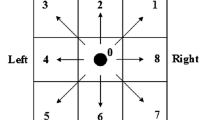Abstract
In the process of evacuation of pedestrian flow, the dynamic strategy choosing among pedestrians greatly influence evacuation efficiency. To address the problem of this dynamic evolutionary game, the direction fuzzy visual field of a moving pedestrian is defined, which fully takes into account the differences between pedestrians in terms of visual field selection. Based on the direction fuzzy visual field, this paper constructs a dynamic evolutionary game model and analyzes the formation and dynamic development of pedestrian flow strategy choosing. It presents the payoff matrix in which heterogeneous pedestrians adjust their strategy according to different payoff. The study results show that the model can effectively demonstrate macroscopic self-organization phenomena of pedestrian flow. The dynamic game equilibrium is related to the radius of the direction fuzzy visual field, the cost of strategic adjustment, the pedestrian density, and the system scale. The radius of the direction fuzzy visual field is bigger, the pedestrians can have more information, and they more likely to adopt competition strategy. There is a critical value for pedestrian density. When pedestrian density is greater than this critical value, the pedestrians will feel crowded and tend to adopt competition strategy. The cost of strategic adjustment is smaller, the pedestrians are more likely to adopt cooperation strategy, a few competitors will gather near the walls. When the cost of strategic adjustment is bigger, the pedestrians tend to adopt competition strategy, a small number of cooperators are gathering near the walls. Therefore, the walls play a very important role in pedestrian flow evacuation. The cellular system scale is bigger, pedestrians are more likely to cooperate.



























Similar content being viewed by others
References
Baek SK, Minnhagen P, Bernhardsson S, Choi K, Kim BJ (2009) Flow improvement caused by agents who ignore traffic rules. Phys Rev E 80(1):016111
Blue VJ, Adler JL (1998) Emergent fundamental pedestrian flows from cellular automata microsimulation. Transp Res Rec 1644:29–36
Blue VJ, Adler JL (1999) Cellular automata microsimulation of bidirectional pedestrian flows. Transp Res Rec 1678:135–141
Blue VJ, Adler JL (2000) Modeling four-directional pedestrian flows. Transp Res Rec 1710:20–27
Blue VJ, Adler JL (2001) Cellular automata microsimulation for modeling bi-directional pedestrian walkways. Transp Res B Methods 35(3):293–312
Fang W, Yang L, Fan W (2003) Simulation of bi-directional pedestrian movement using a cellular automata model. Phys A 321(3–4):633–640
Helbing D, Molnar P (1995) Social force model for pedestrian dynamics. Phys Rev E 51(5):4282–4286
Henderson LF (1974) On the fluid mechanics of human crowd motion. Transp Res 8(6):509–515
Henein CM, White T (2007) Macroscopic effects of microscopic forces between agents in crowd models. Phys A 373:694–712
Kaptein M, Markopoulos P, Ruyter B, Aarts E (2010) Persuasion in ambient intelligence. J Ambient Intell Hum Comput 1(1):43–56
Kim SY, Koo HJ, Song HY (2016) A study on influence of human personality to location selection. J Amb Intel Hum Comp 7(2):267–285
Kim SY, Koo HJ, Song HY (2018) A study on estimation of human personality from location visiting preference. J Ambient Intell Hum Comput 9(3):629–642
Kirchner A, Schadschneider A (2002) Simulation of evacuation processes using a bionics inspired cellular automaton model for pedestrian dynamics. Phys A 312:206–276
Li S, Wang J, Liu Y (2017) Experimental features and mathematical model of pedestrian evacuation with asymmetrical pedestrian distribution. Sci Sin Technol 47(4):423–436
Martin AN, Robert MM (1993) The spatial dilemmas of evolution. Int J Bifurc Chaos 3(1):35–78
Nishinari K (2009) Jamology: physics of self-driven particles and toward solution of all jams. Springer, Berlin
Ren G, Lu L, Wang W (2012) Modeling bi-direction pedestrian flow by cellular automata and complex network theories. Acta Phys Sin 61:144501
Shields TJ, Boyce KE (2000) A study of evacuation from large retail stores. Fire Saf J 35(1):25–49
Tang T, Wu Y, Huang J, Caccetta L (2012) An aircraft boarding model accounting for passengers’ individual properties. Transp Res C Emerg Technol 22:1–16
Xu Y, Huang H (2012) Simulating of exit choosing in pedestrian evacuation with consideration of the direction visual field. Phys A 391(4):991–1000
Yanagisawa D, Tomoeda A, Nishinari K (2012) Improvement of pedestrian flow by slow rhythm. Phys Rev E 85(1):016111
Yang L, Li J, Liu S (2008) Simulation of pedestrian counter-flow with right-moving preference. Phys A 387(13):3281–3289
Yang L, Liu S, Li J, Zhu K (2009) Informatiton-based evacuation and its cellular automaton simulation. Int J Mod Phys C 20(10):1583–1596
Yue H, Hao H, Chen X, Shao C (2007) Simulation of pedestrian flow on square lattice based on cellular automata model. Phys A 384(2):567–588
Yue H, Guan H, Zhang J, Shao C (2010) Study on bi-direction pedestrian flow using cellular automata simulation. Phys A 389(3):527–539
Yue H, Zhang X, Chen G, Shao C (2012) Simulation of pedestrian evacuation with asymmetrical pedestrian layout. Acta Phys Sin 61:130509
Zhan Y, Kuroda T (2014) Wearable sensor-based human activity recognition from environmental background sounds. J Ambient Intell Hum Comput 5(1):77–89
Zhao H, Gao Z (2010) Reserve capacity and exit choosing in pedestrian evacuation dynamics. J Phys A Math Theor 43(10):105001
Acknowledgements
This paper was supported by the National Natural Science Foundation of China (Grant no. 71761025), the Humanities and Social Science Research Foundation of Education of China (Grant no. 12YJC630100) and Lanzhou Jiaotong University and Tianjin University Joint Innovation Fund Project of China (Grant no. 2019058). The authors deeply appreciates the support and would also like to thank the anonymous reviewers for their suggestions.
Author information
Authors and Affiliations
Corresponding author
Additional information
Publisher's Note
Springer Nature remains neutral with regard to jurisdictional claims in published maps and institutional affiliations.
Rights and permissions
About this article
Cite this article
Li, Sw., Wang, Jq. & Zhang, Yz. Simulation study on pedestrian strategy choice based on direction fuzzy visual field. J Ambient Intell Human Comput 11, 827–843 (2020). https://doi.org/10.1007/s12652-019-01389-w
Received:
Accepted:
Published:
Issue Date:
DOI: https://doi.org/10.1007/s12652-019-01389-w




